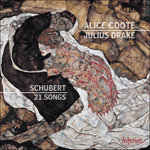
Welcome to Hyperion Records, an independent British classical label devoted to presenting high-quality recordings of music of all styles and from all periods from the twelfth century to the twenty-first.
Hyperion offers both CDs, and downloads in a number of formats. The site is also available in several languages.
Please use the dropdown buttons to set your preferred options, or use the checkbox to accept the defaults.

| Alice Coote (mezzo-soprano), Julius Drake (piano)» More |
The text suggests a moto perpetuo with a flurry of semiquavers. Reichardt set it thus in 1794, as did Zelter in 1812. Schubert of course follows suit; he might have known these settings but it seems more likely that it was Goethe's text alone which suggested the restless Bewegung. Nevertheless the whole song has the characteristics of the North German school. It is seldom that one finds real speed of this kind in a Schubert song, but one encounters it often enough in songs by Mendelssohn (Zelter's pupil) such as Hexenlied, Reiselied, Neue Liebe and so on. There is no room for a pause for thought in a song like this. The construction of the whole is very tight, the piano is ceaselessly occupied in its a role as rhythmic power-generator; the effect of this brief scherzo would, in instrumental terms, be like the whirrings of a faultlessly oiled piece of machinery were it not for the anguish and elation which the human voice alone can express.
The introduction is a miracle (and very hard to play, as generations of accompanists have discovered). The whirling semiquavers in the right hand are marked sempre ligato; the ascending scale in the left hand in crotchets and quavers, partially chromatic and marked sempre staccato, sturdily underpins the flurry and pushes it forward. Thus ambivalence of feeling is immediately established, even in the articulation of the accompaniment. These six bars (over in a trice) present a bewildering succession of chords starting in E major and returning there after the tempest. During this prelude we feel that the singer has attempted to find an exit from the emotional maze, but having failed to do so has to stand his ground, his back against the wall, and explain his case. The singer's task is far from easy because a vocal heroism is required which is comparatively rare in Schubert. The high-lying 'Ohne Rast und Ruh' can only be attempted by singers with something of an operatic top. The gifted tenor Ludwig Tietze sung it at a concert in Vienna in 1824; this was less material less suited to the baritone Vogl. The second verse is marked piano which is essential for the introspective phrase 'Lieber durch Leiden wollt' ich mich schlagen' which contrasts with the first verse's descriptions of the wildness of nature. For the third verse ('Alle das Neigen von Herzen zu Herzen') the key signature changes to G major and semiquavers are replaced by triplets; this tiny adjustment to the accompaniment gives an impression of relative repose – we are transported with the poet's mind back to an intimate moment with Charlotte; the musical sequence – the second phrase a tone higher than the first – emblematic of leaning and yearning. The words 'Wie soll ich flieh'n? Wälderwärts zieh'n?' are brilliantly set as wildly rhetorical phrases (taking to the woods is no serious option) and 'Alles vergebens!' is a howl of pain almost animal-like in its intensity. Note the stretched out cadence (Alles), and the strength of the modulation into C sharp minor (vergebens). The effect of this moment, dominant to tonic, is powerfully suggestive of physical movement, like punching the air ('Oh damn!') in frustration. There are challenges around every corner here: the two bars of 'Krone des Lebens' (marked mezzo forte) are juxtaposed with two bars of 'Glück ohne Ruh' (marked piano), a mercurial change for both singer and pianist. The elongated setting of 'Liebe' towards the end (an E held high over the stave for four bars) is master-stroke; it suggests both rapture and pain by means of the tiniest changes of the supporting harmonies (Lachen und Weinen-like) which are all contained within the possibilities of one plangent note held in the voice as if to emphasise that love is an umbrella word for myriad feelings. The postlude descends into the nether regions of the keyboard and scurries to its offbeat and puckish conclusion, a frisson under the pianist's hands. Despite all the talk of pain and so on, the final impression of this music is that it is all worth it, that love is an adventure and delicious.
from notes by Graham Johnson © 1995
 Schubert: 21 Songs Schubert: 21 SongsOne of the leading mezzos of our day in a Schubert recital which offers seventy minutes of pure pleasure.» More |
 Schubert: The Complete Songs Schubert: The Complete Songs‘This would have been a massive project for even the biggest international label, but from a small independent … it is a miracle. An ideal Christ ... ‘Please give me the complete Hyperion Schubert songs set—all 40 discs—and, in the next life, I promise I'll "re-gift" it to Schubert himself … fo ...» More |

